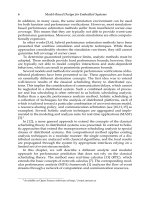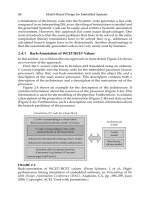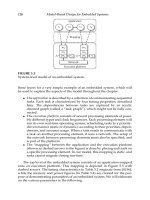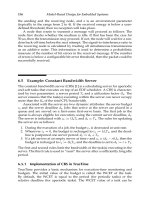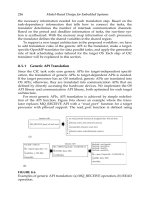Model-Based Design for Embedded Systems- P52 doc
Bạn đang xem bản rút gọn của tài liệu. Xem và tải ngay bản đầy đủ của tài liệu tại đây (529.55 KB, 10 trang )
Nicolescu/Model-Based Design for Embedded Systems 67842_C014 Finals Page 486 2009-10-2
486 Model-Based Design for Embedded Systems
36. J. Templ. Tdl specification and report. Technical Report C059, Dept.
of Computer Science, Univ. of Salzburg, 2004. -
salzburg.at/pubs/reports/T001.pdf.
37. Verimag. If verification tool. async/IF/
index.htm.
Nicolescu/Model-Based Design for Embedded Systems 67842_C015 Finals Page 487 2009-10-2
15
Multi-Viewpoint State Machines for Rich
Component Models
Albert Benveniste, Benoît Caillaud, and Roberto Passerone
CONTENTS
15.1 Introduction and Requirements 487
15.2 Components and Contracts 490
15.3 Extended State Machines 495
15.3.1 Variables and Ports, Events and Interactions,
ContinuousDynamics 495
15.3.2 ESM Definition 496
15.4 HRC State Machines 501
15.5 Mathematical Syntax for the Labeling Functions of HRC
StateMachines 503
15.5.1 Expressions and Differential Expressions 504
15.5.2 Invariants 504
15.5.3 Mathematical Syntax for Transition Relation trans 505
15.5.4 Products in Terms of Guards and Actions 506
15.6 Categories as Specialization of HRC State Machines 507
15.6.1 Discrete Functional Category 507
15.6.2 Timed Category 507
15.6.3 Hybrid Category 509
15.6.4 Safety or Probabilistic Category 510
15.6.5 Illustrating Multi-Viewpoint Composition 512
15.7 Conclusion 515
Acknowledgment 516
References 516
15.1 Introduction and Requirements
This chapter presents the modeling effort that sustains the workrelated to
the IP-SPEEDS heterogeneous rich component (HRC) metamodel, its associ-
ated multiple viewpoint contract formalism, and the underlying mathemat-
ical model of machines supporting such contracts. We put the emphasis on
combining different viewpoints and providing a simple and elegant notion
of parallel composition.
487
Nicolescu/Model-Based Design for Embedded Systems 67842_C015 Finals Page 488 2009-10-2
488 Model-Based Design for Embedded Systems
The motivations behind this work are the drastic organizational changes
that several industrial sectors involving complex embedded systems have
experienced—aerospace and automotive being typical examples. Initially
organized around large, vertically integrated companies supporting most of
the design in house, these sectors were restructured in the 1980s because of
the emergence of sizeable competitive suppliers. Original equipment man-
ufacturers (OEM) performed system design and integration by importing
entire subsystems from suppliers. This, however, shifted a significant por-
tion of the value to the suppliers, and eventually contributed to late errors
that caused delays and excessive additional cost during the system inte-
gration phase. In the past decade, these industrial sectors went through a
profound reorganization in an attempt by OEMs to recover value from the
supply chain, by focusing on those parts of the design at the core of their
competitive advantage. The rest of the system was instead centered around
standard platforms that could be developed and shared by otherwise com-
petitors. Examples of this trend are AUTOSAR in the automotive indus-
try [10] and integrated modular avionics (IMA) in aerospace [7]. This new
organization requires extensive virtual prototyping and design space explo-
ration, where component or subsystem specification and integration occur at
different phases of the design, including at the early ones [19].
Component-based development has emerged as the technology of choice
to address the challenges that result from this paradigm shift. Our objective is
to develop a component-based model that is tailored to the specific require-
ment of system development with a highly distributed OEM/supplier chain.
This raises the novel issue of dividing and distributing responsibilities
between the different actors of the OEM/supplier chain. The OEM wants
to define and know precisely what a given supplier is responsible for. Since
components or subsystems interact, this implies that the responsibility for
each entity in the area of interaction must be precisely assigned to a given
supplier, and must remain unaffected by others. Thus, each supplier is
assigned a design task in the form of a goal, which we call “guarantee or
promise” that involves only entities for which the supplier is responsible.
Other entities entering the subsystem for design are not under the respon-
sibility of this supplier. Nonetheless, they may be subject to constraints
assigned to the other suppliers, that can therefore be offered to this sup-
plier as “assumptions.” Assumptions are under the responsibility of other
actors of the OEM/supplier chain but can be used by this supplier to sim-
plify the task of achieving its own promises. This mechanism of assump-
tions and promises is structured into “contracts” [9], which form the essence
of distributed system development involving complex OEM/supplier
chains.
In addition to contracts, supporting an effective concurrent system devel-
opment requires the correct modeling of both interfaces and open systems,
as well as the ability to talk about partial designs and the use of abstraction
mechanisms. This is especially true in the context of safety critical embedded
Nicolescu/Model-Based Design for Embedded Systems 67842_C015 Finals Page 489 2009-10-2
Multi-Viewpoint State Machines 489
systems. In this case, the need for high-quality, zero-defect software calls
for techniques in which component specification and integration are sup-
ported by clean mathematics that encompass both static and “dynamic”
semantics—this means that the behavior of components and their compo-
sition, and not just their port and type interface, must be mathematically
defined. Furthermore, system design includes various aspects—functional,
timeliness, safety and fault tolerance, etc.—involving different teams with
different skills using heterogeneous techniques and tools. We call each of
these different aspects a “viewpoint” of the component or of the system. Our
technology of contracts is based on a mathematical foundation consisting of
a model of system that is rich enough to support the different viewpoints of
system design, and at the same time clean and simple enough to allow for the
development of mathematically sound techniques. We build on these foun-
dations to construct a more descriptive state-based model, called the HRC
model, that describes the relationships between the parts of a component in
an executable fashion. It is the objective of this chapter to present this higher
level model. Nonetheless, we also provide a quick overview of the contract
model it is intended to support—readers interested in details regarding this
contract framework are referred to [5,6].
Our notion of contract builds on similar formalisms developed in related
fields. For example, a contract-based specification was applied by Meyer in
the context of the programming language Eiffel [17]. In his work, Meyer uses
“preconditions” and “postconditions” as state predicates for the methods
of a class, and “invariants” for the class itself. Similar ideas were already
present in seminal work by Dijkstra [12] and Lamport [16] on “weakest
preconditions” and “predicate transformers” for sequential and concur-
rent programs, and in more recent work by Back and von Wright, who
introduce contracts [4] in the “refinement calculus” [3]. In this formalism,
processes are described with guarded commands operating on shared vari-
ables. This formalism is best suited to reason about discrete, untimed process
behavior.
More recently, De Alfaro and Henzinger have proposed interface auto-
mata as a way of expressing constraints on the environment in the case
of synchronous models [11]. The authors have also extended the approach
to other kinds of behaviors, including resources and asynchronous behav-
iors [8,15]. Our contribution here consists in developing a particular
formalism for hybrid continuous-time and discrete state machines where
composition is naturally expressed as intersection. We show how to trans-
late our model to the more traditional hybrid automata model [14]. In addi-
tion, we identify specialized categories of automata for the cases that do not
need the full generality of the model, and introduce probabilities as a way of
representing failures.
The chapter is structured as follows. We will first review the concepts of
component and contract from a semantic point of view in Section 15.2. We
then describe the extended state machine (ESM) model in Section 15.3 and
Nicolescu/Model-Based Design for Embedded Systems 67842_C015 Finals Page 490 2009-10-2
490 Model-Based Design for Embedded Systems
compare it to a more traditional hybrid model in Section 15.4. The syntax
and the expressive power used for expressions in the transitions of the state-
based model is reviewed in Section 15.5, followed, in Section 15.6, by the
specialization of the model into different categories to support alternative
viewpoints. Several examples complement the formalism throughout the
chapter.
15.2 Components and Contracts
Our model is based on the concept of “component.” A component is a hier-
archical entity that represents a unit of design. Components are connected
together to form a system by sharing and agreeing on the values of certain
ports and variables. A component may include both “implementations” and
“contracts.” An implementation M is an instantiation of a component and
consists of a set P of ports and variables (in the following, for simplicity, we
will refer only to ports) and of a set of behaviors, or runs, also denoted by
M, which assign a history of “values” to ports. Because implementations and
contracts may refer to different viewpoints, as we shall see, we refer to the
components in our model as HRC.
We build the notion of a contract for a component as a pair of assertions,
which express its assumptions and promises. An assertion E is a property
that may or may not be satisfied by a behavior. Thus, assertions can again
be modeled as a set of behaviors over ports, precisely as the set of behaviors
that satisfy it. An implementation M satisfies an assertion E whenever they
are defined over the same set of ports and all the behaviors of M satisfy the
assertion, that is, when M ⊆ E.
A contract is an assertion on the behaviors of a component (the promise)
subject to certain assumptions. We therefore represent a contract C as a pair
(A, G), where A corresponds to the assumption, and G to the promise. An
implementation of a component satisfies a contract whenever it satisfies its
promise, subject to the assumption. Formally, M ∩ A ⊆ G, where M and C
have the same ports. We write M |= C when M satisfies a contract C. There
exists a unique maximal (by behavior containment) implementation satisfy-
ing a contract C, namely, M
C
=G ∪¬A. One can interpret M
C
as the implica-
tion A ⇒ G. Clearly, M |= (A, G) if and only if M |= (A, M
C
), if and only if
M ⊆ M
C
. Because of this property, we can restrict our attention to contracts
of the form C =(A, M
C
), which we say are in “canonical form,” without los-
ing expressiveness. The operation of computing the canonical form, that is,
replacing G with G ∪¬A, is well defined, since the maximal implementa-
tion is unique and idempotent. Working with canonical forms simplifies the
definition of our operators and relations, and provides a unique representa-
tion for equivalent contracts.
Nicolescu/Model-Based Design for Embedded Systems 67842_C015 Finals Page 491 2009-10-2
Multi-Viewpoint State Machines 491
The combination of contracts associated to different components can
be obtained through the operation of parallel composition. If C
1
=(A
1
, G
1
)
and C
2
=(A
2
, G
2
) are contracts (possibly over different sets of ports), the
composite must satisfy the guarantees of both, implying an operation of
intersection. The situation is more subtle for assumptions. Suppose first that
the two contracts have disjoint sets of ports. Intuitively, the assumptions of
the composite should be simply the conjunction of the assumptions of each
contract, since the environment should satisfy all the assumptions. In gen-
eral, however, part of the assumptions A
1
will be already satisfied by com-
posing C
1
with C
2
, acting as a partial environment for C
1
. Therefore, G
2
can
contribute to relaxing the assumptions A
1
. And vice versa. The assumption
and the promise of the composite contract C =(A, G) can therefore be com-
puted as follows:
A = (A
1
∩A
2
) ∪¬(G
1
∩G
2
), (15.1)
G = G
1
∩G
2
, (15.2)
which is consistent with similar definitions in other contexts [11,13,18]. C
1
and C
2
may have different ports. In that case, we must extend the behav-
iors to a common set of ports before applying Equations 15.1 and 15.2. This
can be achieved by an operation of inverse projection. Projection, or elimina-
tion, in contracts requires handling assumptions and promises differently, in
order to preserve their semantics. For a contract C =(A,G) and a port p,the
“elimination of p in C” is given by
[
C
]
p
= (∀pA, ∃pG) (15.3)
where A and G are seen as predicates. Elimination trivially extends to finite
sets of ports, denoted by
[
C
]
P
, where P is the considered set of ports. For
inverse elimination in parallel composition, the set of ports P to be consid-
ered is the union of the ports P
1
and P
2
of the individual contracts.
Parallel composition can be used to construct complex contracts out of
simpler ones, and to combine contracts of different components. Despite hav-
ing to be satisfied simultaneously, however, multiple viewpoints “associated
to the same component” do not generally compose by parallel composition.
We would like, instead, to compute the conjunction of the contracts, so
that if M |= C
f
C
t
, then M |= C
f
and M |= C
t
. This can best be achieved by
first defining a partial order on contracts, which formalizes a notion of sub-
stitutability, or refinement. We say that C =(A,G) “dominates” C
=(A
, G
),
written C C
, if and only if A ⊇ A
and G ⊆ G
, and the contracts have
the same ports. Dominance amounts to relaxing assumptions and reinforc-
ing promises, therefore strengthening the contract. Clearly, if M |= C and
C C
, then M |= C
.
Given the ordering of contracts, we can compute greatest lower bounds
and least upper bounds, which correspond to taking the conjunction
Nicolescu/Model-Based Design for Embedded Systems 67842_C015 Finals Page 492 2009-10-2
492 Model-Based Design for Embedded Systems
and disjunction of contracts, respectively. For contracts C
1
=(A
1
, G
1
) and
C
2
=(A
2
, G
2
) (in canonical form), we have
C
1
C
2
= (A
1
∪A
2
, G
1
∩G
2
), (15.4)
C
1
C
2
= (A
1
∩A
2
, G
1
∪G
2
). (15.5)
The resulting contracts are in canonical form. Conjunction of contracts
amounts to taking the union of the assumptions, as required, and can there-
fore be used to compute the overall contract for a component starting from
the contracts related to multiple viewpoints. The following example illus-
trates the need for two different composition operators.
Example 15.1 (Viewpoint Synchronization) We discuss here an example of
viewpoint synchronization. Assume two contracts C
i
, i=1,2 modeling two differ-
ent viewpoints attached to a same rich component C. For example, let C
1
=(A
1
, G
1
)
be a viewpoint in the functional category and C
2
=(A
2
, G
2
) be a viewpoint of the
timed category.
Assumption A
1
specifies allowed data pattern for the environment,
whereas A
2
sets timing requirements for it. Since contracts are in canonical
forms, the promise G
1
itself says that, if the environment offers the due data
pattern, then a certain behavioral property can be guaranteed. Similarly, G
2
says that, if the environment meets the timing requirements, then outputs
will be scheduled as wanted and deadlines will be met. Thus, both G
i
, i=1,2
are implications.
The greatest lower bound C
1
C
2
can accept environments that satisfy
either the functional assumptions, or the timing assumptions, or both. The
promiseof C
1
C
2
is the conjunction of the two implications: If the envi-
ronment offers the due data pattern, then a certain behavioral property can
be guaranteed, and, if the environment meets the timing requirements, then
outputs will be scheduled as wanted and deadlines will be met. When both
the environment offers the due data pattern and the environment meets
the timing requirements, remark that both a certain behavioral property
can be guaranteed and outputs will be scheduled as wanted and deadlines
will be met.
To have a closer look at the problem, assume first that the two viewpoints
are orthogonal or unrelated, meaning that the first viewpoint, which belongs
to the functional category, does not depend on dates, while the second view-
point does not depend on the functional behavior (e.g., we have a dataflow
network of computations that is fixed regardless of any value at any port).
Let these two respective viewpoints state as follows:
• If the environment alternates the values
T, F, T, on port b, then the
value carried by port x of component C never exceeds 5.
• If the environment provides at least one data per second on port b, then
component C can issue at least one data every 2 s on port x.
Nicolescu/Model-Based Design for Embedded Systems 67842_C015 Finals Page 493 2009-10-2
Multi-Viewpoint State Machines 493
TFT ! TFT
>5
<5
>5
>.5ds
>.5ds
<5
>5
<.5ds
<5
<.5ds
>5
>.5ds
>.5ds
<5
>5
<.5ds
<5
<.5ds
>5
>.5ds
>.5ds
<5
>5
<.5ds
<5
<.5ds
>5
>.5ds
>.5ds
<5
>5
<.5ds
<5
<.5ds
>5
>5
>.5ds
>.5ds
<5
<5
<.5ds
<.5ds
>5
>.5ds
>.5ds
<5
>5
<.5ds
<5
<.5ds
>5
>.5ds
>.5ds
<5
>5
<.5ds
<5
<.5ds
>5
>.5ds
>.5ds
<5
<5
>5
<.5ds
<.5ds
>5
<5
A
f
lifted G
f
lifted A
t
lifted G
t
lifted
TFT ! TFT
>.5ds
<.5ds
A
t
>lds <lds
>.5ds
<.5ds
G
t
A
f
G
f
>lds <lds
>lds
TFT
<lds
TFT
>lds
!TFT
<lds
!TFT
>lds
TFT
<lds
TFT
>lds
!TFT
<lds
!TFT
>lds
TFT
<lds
TFT
>lds
!TFT
<lds
!TFT
>lds
TFT
<lds
TFT
>lds
!TFT
<lds
!TFT
>lds
TFT
<lds
TFT
>lds
!TFT
<lds
!TFT
>lds
TFT
<lds
TFT
>lds
!TFT
<lds
!TFT
>lds
TFT
<lds
TFT
>lds
!TFT
<lds
!TFT
>lds
TFT
<lds
TFT
>lds
!TFT
<lds
!TFT
FIGURE 15.1
Truth tables for the synchronization of categories.
These two viewpoints relate to the same rich component. Still, havingthe two
contracts (A
i
, G
i
), i=funct,timed for C should mean that if the environment
satisfies the functional assumption, then C satisfies the functional guaran-
tees. Also, if the environment satisfies the timing assumption, then C satis-
fies the timing guarantees. Figure 15.1 illustrates the greatest lower bound of
the viewpoints belonging to two different categories, and compares it with
their parallel composition, introduced in Section 15.2. For this case, the right
definition for viewpoint synchronization is the greatest lower bound.
The four diagrams on the top are the truth tables of the functional cate-
gory C
f
and its assumption A
f
and promise G
f
, and similarly for the timed
category C
t
. Note that these two contracts are in canonical form. In the mid-
dle, we show the same contracts lifted to the same set of variables b, d
b
, x,
and d
x
, combining function and timing. On the bottom, the two tables on
the left are the truth tables of the greatest lower bound C
f
C
t
. For com-
parison, we show on the right the truth tables of the parallel composition
C
1
C
2
, revealing that the assumption is too restrictive and not the one
expected.
So far we discussed the case of noninteracting viewpoints. But in gen-
eral, viewpoints may interact as explained in the following variation of
the same example. Assume that the viewpoints (the first one belonging to
Nicolescu/Model-Based Design for Embedded Systems 67842_C015 Finals Page 494 2009-10-2
494 Model-Based Design for Embedded Systems
b
Activ
Activ
Funct
Timed
xbx
d
b
d
x
dα
T
αT
d
x
d
b
FIGURE 15.2
Illustrating the synchronization of viewpoints.
the functional category, while the other one belongs to the timed category)
interact as follows:
• If the environment alternates the values
T, F, T, on port b, then the
value carried by port x of C never exceeds 5; if x outputs the value 0,
then an exception is raised and a handling task T is executed.
• If the environment provides at least one data per second on port b, then
C can issue at least one data every 2 s on port x; when executed, task T
takes 5 s for its execution.
For this case, the activation port α
T
of task T is an output port of the func-
tional view, and an input port of the timed view. This activation port is
boolean; it is output every time the component is activated and is true when
an exception is raised. Then, the timed viewpoint will involve α
T
and d
α
T
as
inputs, and will output the date d
T
of completion of the task T according to
the following formula: d
T
=(d
α
T
+ 5) when (α
T
=T).Notethatd
α
T
has no
meaning when α
T
=F.
Here we had an example of connecting an output of a functional view-
point to an input of a timed viewpoint. Note that the converse can also occur.
Figure 15.2 illustrates the possible interaction architectures fora synchroniza-
tion viewpoint.
Discussion. So far we have defined contracts and implementations in
terms of abstract assertions, that is, sets of runs. In Sections 15.3 and 15.4,
we describe in more precise terms the mathematical nature of these abstract
assertions.
To provide intuition for our design choices, we start by comparing two
alternative views of system runs, as illustrated in Figure 15.3. In the classical
approach, shown in Figure 15.3a, transitions take no time; time and contin-
uous dynamics progress within states; they are specified by state invariants
and guarded. The alternative approach is dual: states are snapshot valua-
tions of variables and take no time; time and continuous dynamics progress
within “thick” transitions that are guarded.
The two approaches have advantages and disadvantages. The classical
approach is preferred for abstractions based on regions, which are valid for
certain classes of models. The alternative approach makes it much easier to
Nicolescu/Model-Based Design for Embedded Systems 67842_C015 Finals Page 495 2009-10-2
Multi-Viewpoint State Machines 495
Zero-time transition
Zero-time transition
Transition(a) (b)
State State State
State State State State
Transition
Transition
State invariant State invariant
Thick transition
Thick transition
Zero-time
state
Zero-time
state
FIGURE 15.3
Runs. (a) Classical approach. (b) Alternative approach. State invariants on
the left, or thick transitions on the right, involve the progress of time and
continuous dynamics such as differential equations.
deal with composition and is able to capture open systems, as we shall see.
Clearly, the two approaches are dual and can be exchanged without harm.
We shall develop the two approaches and relate them throughout this
chapter.
15.3 Extended State Machines
ESMs follow the second approach illustrated in Figure 15.3. They are our pre-
ferred model, because of the simplicity of its associated parallel composition.
15.3.1 Variables and Ports, Events and Interactions,
Continuous Dynamics
Interaction between viewpoints and components is achieved by synchroniz-
ing events and variables involved in both discrete and continuous dynamics.
Synchronization events take place on ports. Dynamic creation or deletion of
ports or variables is not supported by the model.
Values are taken in a unique domain D that encompasses all usual data
types (booleans, enumerated types, integers, real numbers, etc.). We shall
distinguish a subdomain D
c
⊂ D in which variables involved in continuous
evolutions take their values; D
c
collects all needed Euclidean spaces to deal
with differential equations or inclusions. Other type consistency issues are
dealt within the static semantics definition of HRC and are disregarded in
the sequel.
We are given a finite set V of “variables”; the set of variables is parti-
tioned into two subsets V =V
d
V
c
: the variables belonging to V
d
are used
exclusively in the discrete evolutions, and those belonging to V
c
can be

